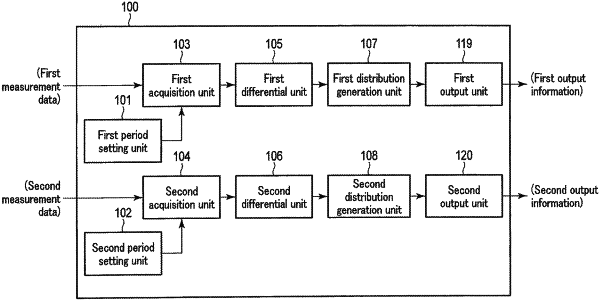| CPC G05B 23/0221 (2013.01) [G05B 19/418 (2013.01); G06N 20/00 (2019.01)] | 17 Claims |

|
1. A data processing apparatus for detecting a drift regarding a time derivative, the apparatus comprising a processor configured to:
acquire first measurement data that is a set of measurement values in a first period among time series data of measurement values of a sensor of interest among a plurality of sensors included in a system;
acquire second measurement data that is a set of measurement values in a second period different from the first period among the time series data of the measurement values of the sensor of interest;
calculate, from the first measurement data, a first differential value in a time direction at a first time included in the first period of the measurement values of the sensor of interest, wherein the first differential value represents a time derivative in the first period of the measurement values of the sensor of interest, wherein the processor calculates a first differential value set that is a set of first differential values calculated by changing the first time in the first period;
calculate, from the second measurement data, a second differential value in a time direction at a second time included in the second period of the measurement values of the sensor of interest, wherein the second differential value represents a time derivative in the second period of the measurement values of the sensor of interest, wherein the processor calculates a second differential value set that is a set of second differential values calculated by changing the second time in the second period;
generate a first differential value distribution using the first differential value set;
generate a second differential value distribution using the second differential value set;
detect whether a drift of the time derivative of the measurement value of the sensor of interest has occurred between the first period and the second period based on the generated first differential value distribution and the generated second differential value distribution, and generate a drift detection signal indicating whether the drift of the time derivative has been detected; and
output the first differential value distribution, the second differential value distribution, and drift information regarding detection of the drift of the time derivative based on the generated drift detection signal,
wherein the measurement values of the plurality of sensors are monitored by a machine learning model to detect an anomaly in the measurement values,
wherein the machine learning model is trained by training data in which a data period is the first period, and the second period is a period after the first period;
wherein the processor executes processing of detecting a drift of the time derivative for each of measurement values of a plurality of the sensors of interest,
wherein the processor detects whether a number of sensors for which the drift of the time derivative is detected is larger than or equal to a threshold value;
wherein the processor generates and outputs the drift information to include information prompting update of the machine learning model when it is detected that the number of sensors for which the drift of the time derivative is detected is larger than or equal to a threshold value.
|